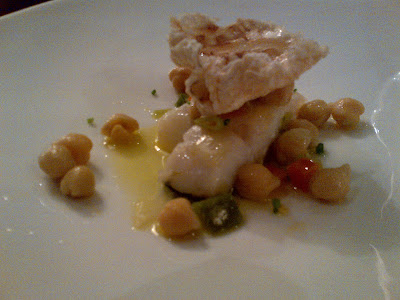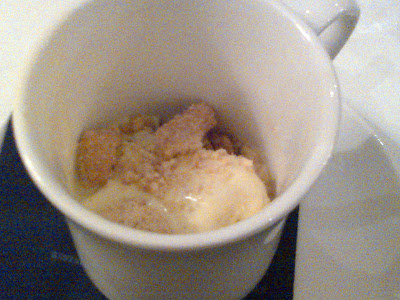La verdad que cuando probé la primera copa con el aceite de oliva puro me sorprendí y hasta le dije a Cheli que como que era la primera vez que tomaba aceite así! Fue la verdad toda una experiencia. He estado en
catas de vino, de cava y champagne, recientemente en una de
quesos y ahora de aceite de oliva. La cata fue en
El Estudio de Ana de la mano de la
Almazara Valle de Ricote y la mano milagrosa de
Freddy Salmeron en la cocina.
To tell you the truth, when I tasted my first glass with pure olive oil I was surprised and even
told Cheli that as it was probably the first time that I took it this way! It was quite an experience. I've been to wine tastings, cava and champagne ones, I was recently in a cheese tasting and now an olive oil one. The
tasting took place at El Estudio de Ana by the hand of the Almazara Valle de Ricote and Freddy Salmeron´s miraculous hand in the kitchen.
Aquí uno que otro dato aprendido durante este grata experiencia.

Almazara??? Confieso que era la primera vez que oía la palabra. Menos mal que hoy en día hay
smartphones y que tengo datos y que existe
Wikipedia porque pude saber
in situ lo que significaba. Para quienes aun están en blanco, aqui les va: La palabra
almazara proviene del árabe المعصرة (al-ma’sara) y significa «lugar donde se exprime» (en referencia a la aceituna u oliva). Con este mecanismo se obtiene, principalmente, aceite de oliva.
Here are some facts that I learned during this great experience.
Almazara??? I confess it was the first time I heard the word. Luckily today we have smartphones and I have a data plan and Wikipedia exists because I knew what it meant in situ. For
those of you who are still in blank, here it is: The word comes from the Arabic
oil press or mill المعصرة (al-Ma'sara) and means "place where squeezed" (referring to
the olive). With this mechanism we obtain mainly olive oil.

El color de aceite no es un factor importante a la hora de determinar su calidad; razón por la que las copas de cata son
azules... para que el ojo no engañe al paladar jejeje... El color del aceite depende de la variedad de aceituna que se utilice
para hacer el aceite y de la época en que se haya recolectado. Hay mas de 262 variedades de aceitunas en España.
The color of oil is not an important factor when determining its quality, reason why the tasting glasses are blue ... so that the eye does not deceive the palate lol... The color of the oil depends on the olive variety used to make the oil and the time in which it was collected. There are over 262 olive varieties in Spain.
Las olivas crecen en el Mediterráneo, California, Sur América, Sur Africa, China y Australia. Todos producen aceite y guess what? a todos les gusta el suyo... Asturias no produce olivas y España produce el 40% del aceite de oliva del mundo. Unas 1.6 millones de tons mientras que el resto del mundo produce 1.9 millones tons. Los españoles consumen 12 kg de aceite de oliva por persona por año y el resto del mundo sólo 0.4kgs (a excepción del la cuenca del Mediterráneo)
Hacen falta 5kgs de aceitunas para obtener 1 lt de aceite de oliva.

Olives grown in the Mediterranean, California, South America, South Africa, China and Australia. All produce olive oil and guess what? everyone likes theirs... Asturias does not produce olives and Spain produces 40% of the world's olive oil. Some 1.6 million tons while the rest of the world produces 1.9 million tons. The
Spanish eat 12 kg of olive oil per person per year while the rest of the
world only 0.4kgs (except the Mediterranean)
We need 5kgs of olives
to make 1 liter of olive oil
Hablando de ese Lt de aceite... Pues hay de distintas categorías
Virgen extra 100% oliva y sin defectos
Virgen 100% oliva y tiene ligeros defectos de oxidación o fermentación
Aceite de Oliva: mezcla de aceites refinados y de aceite virgen
Speaking of that bottle of olive oil ... There are different categories
Extra Virgin Olive Oil 100% olives and flawless
Virgin Olive Oil 100% olives and has slight defecst in oxidation or fermentation
Olive Oil: a blend of refined oils and virgin ones
Ahora al business, esa noche catamos 4 variedades: Changlo real, Cuquillo, Arbequina y Picual. De los cuatro, mi favorito el Cuquillo (que según es el equivalente al Manzanillo)
Para catar la copa debe estar caliente. Por ello se sostiene con ambas manos y se tapa para que no se evapore el olor. Una vez destapado se huele y bueno, aqui como con el vino y todo las demás cosas que uno huele. A cada quien le parece que huele a... y que le recuerda a... Después se prueba y uff como decía al inicio es super curioso y la verdad que una sorpresa.
Changlo real: olia muy bien y me recordó a la ensalada capresa que había cenado la noche anterior. Al probarlo al inicio parecía que no sabía a nada y luego BAM! picaba en las amigdalas un montón. Menos mal que el picor no era persistente.

El
Cuquillo era mas denso y oleso en boca para mi, aunque dijeron que no tenía tanto cuerpo como el anterior. Definitivamente mucho menos picante que el Chenglo.
Arbequina: era balanceado y seguro quedaría muy rico con pan... allí lo que teníamos para la limpieza del paladar entre uno y otro era manzana verde asi que tendré que comprar una botellita de este oro amarillo para quitarme el antojo.
Picual: este parece inofensivo al inicio, es de los que podríamos llamar pica pasito, comienza suave y al final pica.
Now down to business. That night we tasted four varieties: Changlo real, Cuquillo, Arbequina and Picual. Of the four, my favorite one was Cuquillo (which, according to them is the equivalent to the Manzanillo variety)To taste it the oil should be warm. Thus you should hold the glass with both hands. It should be covered so the smell does not evaporate. Once uncovered smell it and, here as with wine and everything else that you smell, each one expresses what they smell ... and what it reminds them of ... And then, you taste it and Uff as I said at the beginning it´s super funny and a real surprise.
Real Changlo: smelled good and it reminded me of the Caprese salad I had eaten the night before. When you taste it, at the begining it seemed it did not taste at all and then BAM! your tonsils sting a lot. Luckily it was not a persistent itching.Cuquillo was more dense in my mouth but they said it did not have as much body as the one before. Definitely a lot less spicy than the last one.Arbequina: balanced and it sure would taste wonderful with bread ... There, what we had to clean the palate between each oil was green apple. So I'll
have to buy a bottle of this yellow gold to take care off the craving lol.Picual: this one seems harmless at first but then bewareit turns spicy.
Después de la cata, unos platos hechos con el aceite catado como base.
Ensalada de hinojo, tomate y sashimi de caballa con aceite de
Cuquillo
Fennel, tomato and mackerel sashimi salad with Cuquillo oil
Huevo pochado con espuma de patata y aceite de Arbequina
Poached egg with potato foam and Arbequina oil
Espumoso D.O. cava Bach Strissimo Brut Nature
Sparkling D.O. Cava Brut Nature Bach Strissimo
*****
Bacalao confitado a 55º con garbanzos, verduritas de la huerta y
Picual
55º Cod confit with chickpeas, garden veggies and Picual
Espumoso D.O. cava Conde de Haro Brut
Sparkling D.O. Brut Cava Conde de Haro
***
Pepito de carrillera de ternera con sus chips de boniato y
Changlo
Beef cheek "pepito" (sandwich) with sweet potato chips and Changlo
Tinto D.O. Alicante Boca Negra 2007
Tinto D.O. Alicante Boca Negra 2007
***
Piña crumble y helado de
Arbequina
Pineapple Arbequina crumble and ice cream
D.O. Jumilla Alceño Dulce - Monastrell 2010
D.O. Alceño Jumilla Dulce - Monastrell 2010



















































